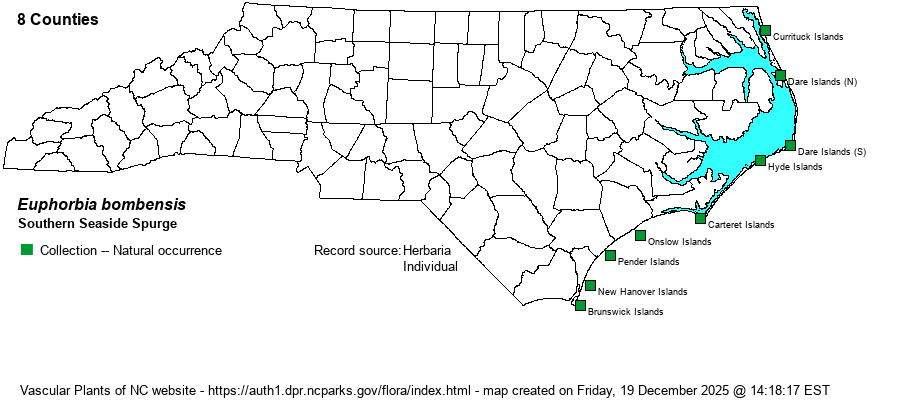| Author | Jacquin | |
| Distribution | Outer Banks and barrier islands only. No mainland records have been verified.
Maritime -- southeastern VA to southern FL and TX; Mex., C.A., Venez. | |
| Abundance | Uncommon to only locally frequent, greatly outnumbered in sites and abundance by the similar Northern Seaside Spurge (E. polygonifolia). This is a Significantly Rare species. | |
| Habitat | Semi-stable to stable dunes and flats, maritime dry grasslands, sandy upper margins of brackish marshes, blowouts and overwash fans. Often occurs with E. polygonifolia, but more often found in sheltered sands behind the main dunes (unlike the other species). |
| Phenology | Flowering and fruiting June-October. | |
| Identification | Several species of Euphorbia grow as prostrate mats. Some of them have pubescent young stems and leaves, but this species, E. cordifolia, and E. polygonifolia are glabrous. E. cordifolia occurs inland, not in maritime situations; the last can be told from Southern Seaside Spurge by larger seeds (2.2-2.6 mm long vs. 1.5-1.9 mm) and strictly terminal inflorescences (vs. terminal and axillary in E. bombensis). This species has leaves a bit darker green than the medium green color of S. polygonifolia leaves, somewhat shorter leaves, and leaves more truncate at the tips than the relative long and more tapered leaves of the common species. When searching for this uncommon species, you likely will encounter the common species many more times. | |
| Taxonomic Comments | Synonyms include E. ammannoides and Chamaesyce ingallsii.
| |
| Other Common Name(s) | Dixie Sandmat | |
| State Rank | S2? [S2S3] | |
| Global Rank | G4G5 | |
| State Status | SR-T | |
| US Status | | |
| USACE-agcp | | |
| USACE-emp | | |

